“You either love it or you hate it,” said a friend of mine. It was the first thing I ever heard about the Italian city of Naples, and the phrase’s authenticity remains intact after all these years. Naples is unlike any other city in Italy: It is busy, loud, and dirty on one hand (many people say it feels like stepping into a Middle-Eastern 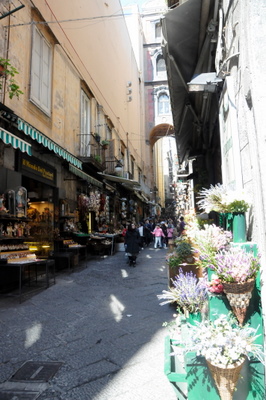 bazaar) and creative, friendly, and picturesque on the other. It is definitely not a quiet, romantic Italian town like Siena or Verona. Threats of pickpockets and a pervasive garbage problem keep many travelers from even visiting the city, while a one-of-a-kind culinary scene, inexpensive shopping, and a vibrant waterfront make it a must-see for others. If you haven’t guessed already, I fall in the latter group.
bazaar) and creative, friendly, and picturesque on the other. It is definitely not a quiet, romantic Italian town like Siena or Verona. Threats of pickpockets and a pervasive garbage problem keep many travelers from even visiting the city, while a one-of-a-kind culinary scene, inexpensive shopping, and a vibrant waterfront make it a must-see for others. If you haven’t guessed already, I fall in the latter group.
The first time I visited Naples, I was immediately taken aback by its sheer bustle. I still attest to seeing a family of six—with a pet—whiz past me on a moped. The streets are small and the traffic is frantic. And the large outdoor market in front of the central train station is overwhelming and seemingly chaotic. However, once I became accustomed to the energy of Naples, I discovered the unique qualities that fueled it.
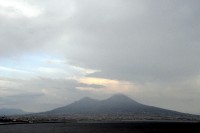 The people in Naples are friendly and welcoming, and always willing to help. For example, the clerk at the hotel where I usually stay is always giving guests tips on the best things to see and do. He also warns of pickpockets and provides extensive advice on how to carry money and cameras. In the stores and restaurants, people are quick to ask you where you are from and to welcome you to their city.
The people in Naples are friendly and welcoming, and always willing to help. For example, the clerk at the hotel where I usually stay is always giving guests tips on the best things to see and do. He also warns of pickpockets and provides extensive advice on how to carry money and cameras. In the stores and restaurants, people are quick to ask you where you are from and to welcome you to their city.
The main tourist destinations in Naples are its two castles, the Naples National 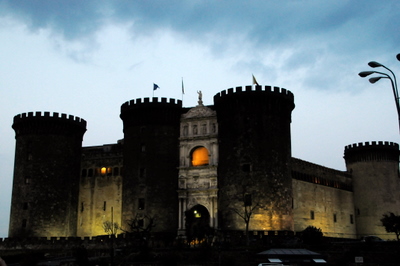 Archaeological Museum—considered the most important archeological museum in Italy—, tours of its underground city Sotterranea, and a waterfront full of beautiful sailboats and traditional fishing boats. The bay of Naples, on which the city sits, provides a clear view of the ancient Vesuvius volcano that buried the nearby city of Pompeii in 79AD. The Castle dell’Ovo is located on a tiny island that is joined to Naples by a short bridge, and is free to visit. Castle Nuovo, which costs 5 euro to enter, is the more striking castle, with ancient stonework and dramatic towers.
Archaeological Museum—considered the most important archeological museum in Italy—, tours of its underground city Sotterranea, and a waterfront full of beautiful sailboats and traditional fishing boats. The bay of Naples, on which the city sits, provides a clear view of the ancient Vesuvius volcano that buried the nearby city of Pompeii in 79AD. The Castle dell’Ovo is located on a tiny island that is joined to Naples by a short bridge, and is free to visit. Castle Nuovo, which costs 5 euro to enter, is the more striking castle, with ancient stonework and dramatic towers.
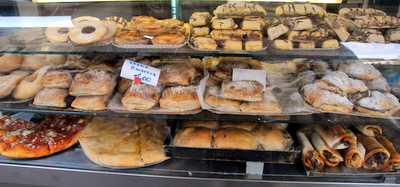 From a culinary perspective, Naples offers traditional Italian foods that cannot be found anywhere else—not even in other Italian cities. Neapolitan pizza is, of course, at the forefront. The street food, which is sold from open storefronts around every corner, is some of the best in Italy. Fried panini stuffed with meats and cheeses, arancini (deep-fried risotto balls stuffed with mozzarella), calzones, and an assortment of fried vegetables and potatoes (sold for 30 cents a piece), should not be missed. Further, the pastries in Naples are incredible. Sfogliatelle is a horn-shaped pastry that looks like it is made with circles of layered flakey crusts. Traditional biscotti are also served, though bear no resemblance to the dried, crunchy biscotti found in the United States. And espresso in Naples is definitively some of the best in Italy.
From a culinary perspective, Naples offers traditional Italian foods that cannot be found anywhere else—not even in other Italian cities. Neapolitan pizza is, of course, at the forefront. The street food, which is sold from open storefronts around every corner, is some of the best in Italy. Fried panini stuffed with meats and cheeses, arancini (deep-fried risotto balls stuffed with mozzarella), calzones, and an assortment of fried vegetables and potatoes (sold for 30 cents a piece), should not be missed. Further, the pastries in Naples are incredible. Sfogliatelle is a horn-shaped pastry that looks like it is made with circles of layered flakey crusts. Traditional biscotti are also served, though bear no resemblance to the dried, crunchy biscotti found in the United States. And espresso in Naples is definitively some of the best in Italy.
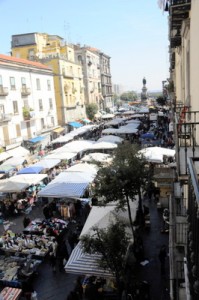 The markets in Naples are a great place to find clothes, shoes, purses, sunglasses, hats, and so on. However, they are known for pickpockets, so keep your money hidden or spread out between different pockets. If you try on shoes, the venders will provide you a seat. And, bartering is a way of life in the markets, so never pay the listed price.
The markets in Naples are a great place to find clothes, shoes, purses, sunglasses, hats, and so on. However, they are known for pickpockets, so keep your money hidden or spread out between different pockets. If you try on shoes, the venders will provide you a seat. And, bartering is a way of life in the markets, so never pay the listed price.
 Finally, the architecture of Naples won’t be forgotten, as huge churches, cathedrals, and other strutures of Medieval, Renaissance, and Baroque periods are found throughout the city. My favorite spots are the Piazza Dante, which boasts a great statue of Dante, and the Piazza del Plebiscito (especially at night). With Naples, I’ve found that looking beyond the crumbling apartment buildings provides an exciting glimpse into a city that is truly unlike any other on earth.
Finally, the architecture of Naples won’t be forgotten, as huge churches, cathedrals, and other strutures of Medieval, Renaissance, and Baroque periods are found throughout the city. My favorite spots are the Piazza Dante, which boasts a great statue of Dante, and the Piazza del Plebiscito (especially at night). With Naples, I’ve found that looking beyond the crumbling apartment buildings provides an exciting glimpse into a city that is truly unlike any other on earth.


Comments